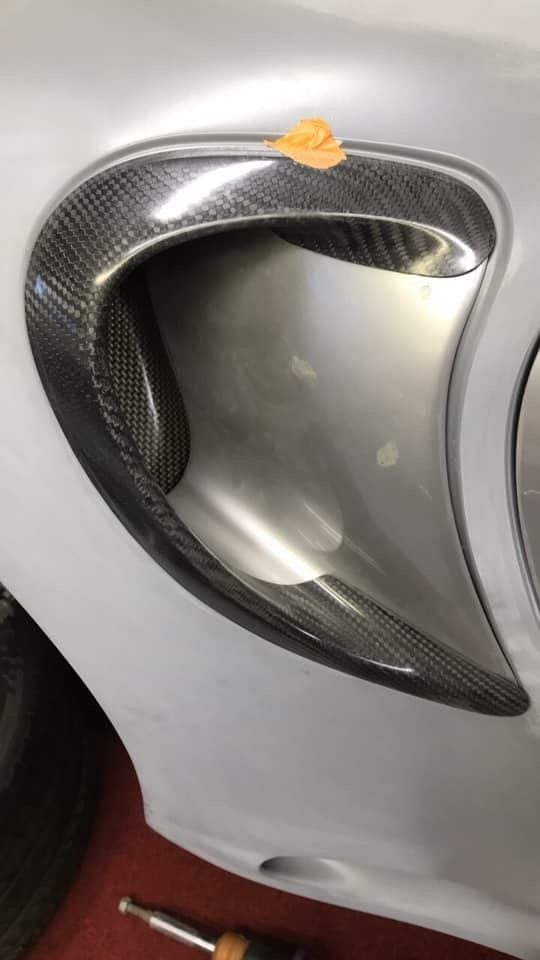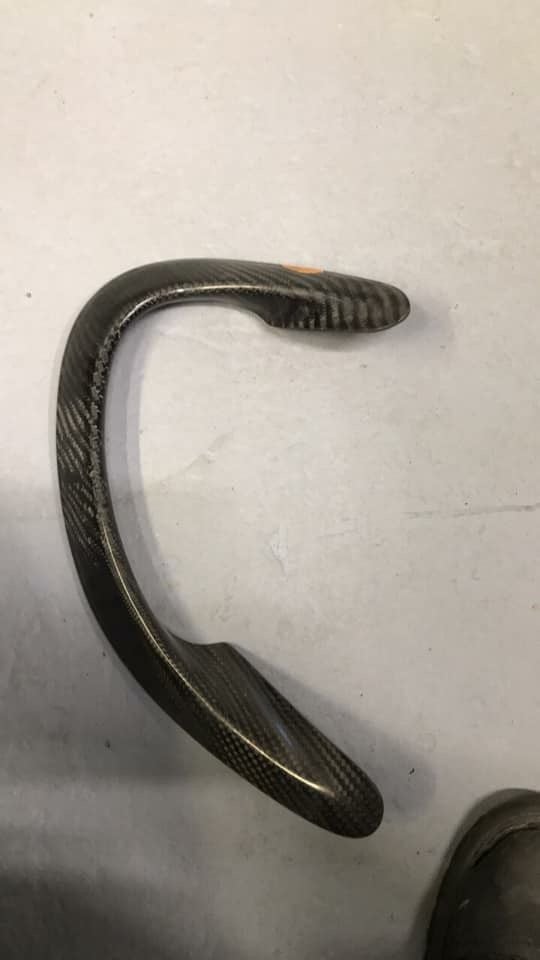Question about side scoop?
#16
Banned
Join Date: Oct 2011
Location: Holy City, South Carolina
Posts: 2,391
Likes: 0
Received 1 Like
on
1 Post
Chris, how would a puller fan be an obstruction on the exit side? Keeping a constant air flow over the surface areas would out weigh the minimal obstruction. It’s not like there’s a flat piece of cardboard there.
#17
Three Wheelin'
The venturi is stronger than any fan that you could fit in that space. Not a huge obstruction, but it would just be something in the way creating turbulence which would weaken the venturi without providing enough airflow to make up for it.
#18
Rennlist Member
Efficiency is important, but IMO there first needs to be an indication that something isn't efficient enough in its current design. I think for street use, a stock 996 Turbo has all the efficiencies needed to produce enough acceleration to manage any situation you reasonably face. If there isn't enough acceleration available for what you're attempting to do, then I would suggest you just not do it.
Quick example of a 7% impact:
Standard conditions is 14.7 psig at 60 degF; let's say you spend some boatload of cash to keep the charge air at 60 degF instead of allowing it to rise to 100 deg. What impact would that have on air density?
Because degrees Rankine is T+460 degrees, the impact is minimal.
(60+460)/(100 + 460) ~ .93
So you improve the air density a whopping 7%
I can get the same 7% increase in air density by increasing the boost pressure from 1 bar to 1.1 bar.
(14.7psi + 1.47psi) / 14.7psi = 7%
You should tweak the air temperature design after you've optimized the pressure; assuming the Porsche engineers left that much on the table to optimize; which I seriously doubt.
IMO.
#19
Three Wheelin'
It isn't about power increase, at least not for me, it is about keeping charge air cooler and IATs down over extended track sessions 20-30+ mins. It's a safety/efficiency thing on track.
Same day, same car, same track from one session to the next I logged IATs before and after adding larger inlets and IAT never went about 85F with inlets where as it spent most of the session without inlets above 85F with spikes up to 100F on the front straight by the 4th lap. After cool down lap pulling into pits, IATs without inlets were ~77F and with inlets ~70F. The lap with the inlets also started off with higher IATs due to car having already ran a session and built up heat... Actually the highest IAT on the inlet log was 88F and it was below 70F within a minute.
I didn't expect this sort of results, but for me, my car, my use.. it's effective.
Same day, same car, same track from one session to the next I logged IATs before and after adding larger inlets and IAT never went about 85F with inlets where as it spent most of the session without inlets above 85F with spikes up to 100F on the front straight by the 4th lap. After cool down lap pulling into pits, IATs without inlets were ~77F and with inlets ~70F. The lap with the inlets also started off with higher IATs due to car having already ran a session and built up heat... Actually the highest IAT on the inlet log was 88F and it was below 70F within a minute.
I didn't expect this sort of results, but for me, my car, my use.. it's effective.
#20
RL Community Team
Rennlist Member
Rennlist Member
It isn't about power increase, at least not for me, it is about keeping charge air cooler and IATs down over extended track sessions 20-30+ mins. It's a safety/efficiency thing on track.
Same day, same car, same track from one session to the next I logged IATs before and after adding larger inlets and IAT never went about 85F with inlets where as it spent most of the session without inlets above 85F with spikes up to 100F on the front straight by the 4th lap. After cool down lap pulling into pits, IATs without inlets were ~77F and with inlets ~70F. The lap with the inlets also started off with higher IATs due to car having already ran a session and built up heat... Actually the highest IAT on the inlet log was 88F and it was below 70F within a minute.
I didn't expect this sort of results, but for me, my car, my use.. it's effective.
Same day, same car, same track from one session to the next I logged IATs before and after adding larger inlets and IAT never went about 85F with inlets where as it spent most of the session without inlets above 85F with spikes up to 100F on the front straight by the 4th lap. After cool down lap pulling into pits, IATs without inlets were ~77F and with inlets ~70F. The lap with the inlets also started off with higher IATs due to car having already ran a session and built up heat... Actually the highest IAT on the inlet log was 88F and it was below 70F within a minute.
I didn't expect this sort of results, but for me, my car, my use.. it's effective.
#21
RL Community Team
Rennlist Member
Rennlist Member
I agree 100%. I don't see the effort and cost worth it for such minor improvements. Between the two variables impacting air density ( pressure and temperature), air temperature has the least impact on density, because in the PV=znRT calculation for density, temperature (T) is measured in degrees Rankine. 60 degF = 520 degR
Quick example of a 7% impact:
Standard conditions is 14.7 psig at 60 degF; let's say you spend some boatload of cash to keep the charge air at 60 degF instead of allowing it to rise to 100 deg. What impact would that have on air density?
Because degrees Rankine is T+460 degrees, the impact is minimal.
(60+460)/(100 + 460) ~ .93
So you improve the air density a whopping 7%
I can get the same 7% increase in air density by increasing the boost pressure from 1 bar to 1.1 bar.
(14.7psi + 1.47psi) / 14.7psi = 7%
You should tweak the air temperature design after you've optimized the pressure; assuming the Porsche engineers left that much on the table to optimize; which I seriously doubt.
IMO.
Quick example of a 7% impact:
Standard conditions is 14.7 psig at 60 degF; let's say you spend some boatload of cash to keep the charge air at 60 degF instead of allowing it to rise to 100 deg. What impact would that have on air density?
Because degrees Rankine is T+460 degrees, the impact is minimal.
(60+460)/(100 + 460) ~ .93
So you improve the air density a whopping 7%
I can get the same 7% increase in air density by increasing the boost pressure from 1 bar to 1.1 bar.
(14.7psi + 1.47psi) / 14.7psi = 7%
You should tweak the air temperature design after you've optimized the pressure; assuming the Porsche engineers left that much on the table to optimize; which I seriously doubt.
IMO.
I doubt it too.
#22
I sold my Joe Toth scoops before I could get some data, but with the OE and proper cooling/heat shielding my IAT are just over ambient rising just a tad under boost.
#23
Instructor
I agree with what you said in your original post, the problem is the car is sculpted in such a way that adding ANY width to the intakes basically looks...bad imo. The scoops already go all the way to the edge. The best solution would be to make a one-piece part that replaces the entire existing scoop and has a slight lip on it to minimize the bulge but of course you would realize minimum gains at maximum cost to do it. Thats one of the main improvements I really love about the 997 fenders, the scoops look way better.
#26
Instructor
As previously mentioned, the inlet temperature is not principally about air density, it's more about detonation margin. The hotter the IAT is, the more the ECU has to pull timing which does directly affect performance as well as potential risk to the engine if it can't compensate enough with timing and richer AFR to use fuel as a coolant (used in planes). One other option is to run water mist spraying on the intercoolers. Air/water intercoolers are more efficient at transferring heat than air/air and can be set to operate only at higher throttle settings. For that matter water/methanol in the intake inlets would also affect temps. A common mod on smaller cars, I also used to use it on 427 66 Corvette to help with low octane fuel which burns too fast. Just some ideas.
#27
Rennlist Member
As previously mentioned, the inlet temperature is not principally about air density, it's more about detonation margin. The hotter the IAT is, the more the ECU has to pull timing which does directly affect performance as well as potential risk to the engine if it can't compensate enough with timing and richer AFR to use fuel as a coolant (used in planes). One other option is to run water mist spraying on the intercoolers. Air/water intercoolers are more efficient at transferring heat than air/air and can be set to operate only at higher throttle settings. For that matter water/methanol in the intake inlets would also affect temps. A common mod on smaller cars, I also used to use it on 427 66 Corvette to help with low octane fuel which burns too fast. Just some ideas.
Do you know whether the stock design is incapable of preventing pre-detonation with 93 octane gas? If it is incapable, then a modification would be beneficial from this standpoint. If it's capable across ambient temperatures that can reasonably be expected, then it doesn't serve a big purpose.
#30
Three Wheelin'


